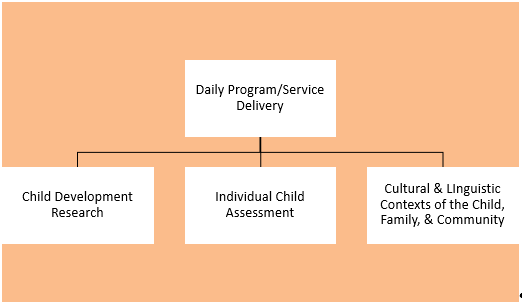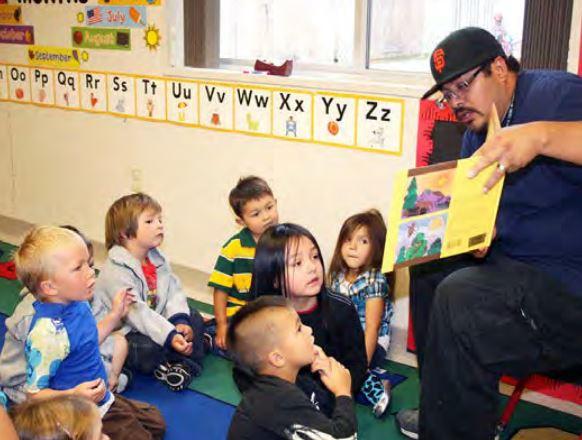23 5.2: Developmentally Appropriate Practices
In 1997, NAEYC released its revised publication on developmentally appropriate practices. This term was formulated by professionals making decisions about the well-being and education of children, on the basis of at least three important pieces of information:
- What is known about child development and learning: Knowledge of age-related human characteristics that permits general predictions within an age range about what activities, materials, interactions, or experiences will be safe, healthy, interesting, achievable, and challenging to children.
- What is known about the strengths, interests, and needs of each individual child in the group: [Necessary] to be able to adapt and be responsive to inevitable individual variation.
- Knowledge of the social and cultural contexts in which children live: [Necessary] to ensure that learning experiences are meaningful, relevant, and respectful for the participating children and their families. (Bredekamp & Copple 1997, 8–9)

With this information, programs are expected to use knowledge of children’s cultural and social settings as a key component of decisions about teaching environments. In 2009, NAEYC released its third revision of the publication (Bredekamp & Copple 2009). In this most recent version, the three types of knowledge identified in the 1997 publication remain. The decision-making process for developmentally appropriate practices is presented in Figure 5.2. [48]

Curriculum in Multicultural Classrooms
The term culturally responsive practices has been used to refer to the implementation of effective teaching practices in diverse early education settings. Culturally responsive practices are teaching to the individual needs of children who are culturally, ethnically, and linguistically diverse. This term implies the integration of assessment and curriculum practices: program staff must learn about the individual abilities and preferences of each of the children enrolled in their program, and then find ways to plan and implement a curriculum that is based upon each individual child’s needs and interests. For example, teachers can use home visits to learn about the child, to observe ways that families interact with their child, and to begin a dialogue with families about their goals for the child.
Classroom Materials
In her 1995 book, The Right Stuff for Children Birth to 8, Martha Bronson offers detailed suggestions for selecting play materials that are safe, appropriate, and supportive of play and development. It is relevant to note here that classroom materials can potentially depict people in stereotypical ways or only contain simplified or inaccurate images of culturally diverse people. Therefore, the challenge is to provide classroom materials that reflect all children, families, and adults in the program, and to eliminate stereotypical or inaccurate materials from daily use. For example, books and dramatic play materials should reflect diversity of gender roles, racial and cultural backgrounds, special needs and abilities, and a range of occupations and ages. Books and environmental print should also represent the different languages of children in the classroom.

The challenge for programs is to establish systems and procedures that take the cultural and linguistic contexts of the children into account. Once in place, these classroom materials should be reviewed on an ongoing basis to ensure that the classrooms reflect all enrolled children without stereotyping. Programs are encouraged to seek information from families and knowledgeable members of the community for their input in equipping classrooms to reflect cultures and languages in respectful ways.
Finally, encouraging children’s language and cognitive growth does not preclude the responsibility to support each child’s sense of wellbeing, the formation of his or her identity, and feelings of security. A consensus within the research is that effective environments for children support all domains of development, and that environments associated with learning outcomes should also provide strong support for social–emotional development (Hart & Risley 1995, 1999; National Research Council and Institute of Medicine 2000; Snow, Burns, & Griffin 1998).
With this in mind, the developmentally, culturally, and linguistically appropriate environment mirrors the ideas, values, attitudes, and cultures of the children it serves (Gestwicki 1995). The following are some specific strategies suggested by Derman Sparks (1989):
- Use images in abundance that represent all children, families, and staff in your program.
- Use images of children and adults from the major ethnic groups in your community and in U.S. society.
- Use images that accurately reflect people’s current daily lives in the U.S. during work and recreational activities.
- Offer a balance among different cultural and ethnic groups.
- Provide a fair balance of images of women and men doing “jobs at home” and “jobs outside home.”
- Provide images of older people of various backgrounds doing different activities.
- Provide images of differently abled people of various backgrounds at work and with their families.
- Use images of diversity in family styles, such as single mothers and fathers, and extended families that are multiracial and multiethnic.
- Use images of important individuals, past and present, and that reflect diversity.
- Exhibit artwork—prints, sculpture, and textiles—by artists of various backgrounds.
Children’s Books
In the past, children’s books generally treated minority groups badly or ignored them completely. In the 1960’s-1970’s, Children’s libraries were supported by federal government. This encouraged publishers to produce many ethnic groups’ books. Banks (1979) stated that “It would be difficult to pinpoint its origin, but it may be safe to assume that the term multicultural literature came after the advent of the multicultural education movement in the 1960s. In 1965, Nancy Larrick wrote “The All White World of Children’s Books” to report almost no Black people appeared in any of America’s children’s books. People began to recognize and include Black people and other minority groups in the books. In 1966, the Council on Interracial Books for Children (CIBC) was founded. CIBC encourages authors to write about their own cultures. In 1969, the American Library Association (ALA) gave the Coretta Scott King Award to excellent Black writers and illustrators. In 1974, the National Council for the Social Studies gave the Carter G. Woodson Award to excellent minority and race children’s books. In 1985 only 18 books were eligible for the Coretta Scott King Award. In the last decade, multicultural literature has begun to flourish. Nowadays, multiculturalism is a big issue. Understanding multicultural issues is important. Banks (1991) stated “By the year 2020, one of every two students in the United States will be a person of color.”. Dietrich & Ralph (1995) stated that “educators should help students explore their own cultures and contribute to intercultural understanding.” [51]
While there may be more multicultural literature now, there is still a lack of diversity in children’s books. Please see the following graphic.

Look for Accuracy
You may notice that there are funhouse mirrors in the graphic. These were chosen to illustrate how “[c]hildren’s literature continues to misrepresent underrepresented communities, and we wanted this infographic to show not just the low quantity of existing literature, but also the inaccuracy and uneven quality of some of those books.” [53]
“Accuracy of cultural representation is a crucial aspect of high quality multicultural literature.” Shioshita (1997, p.1) stated that books must have current, correct information, be careful of not reinforcing stereotypes, and use actual language in books. Harris (1993,p.50) also stated, “Information should be factual and up-to-date.” In other words, an accurate multicultural book must give readers the right information about other cultures. When readers understand other people who live in the world have some similarities with them, they do not have xenophobia anymore. “A good multicultural book must avoid racial and cultural stereotyping” (Tunnell, M., & Jacobs, S., 2008, p.190).
Having cultural background knowledge to write multicultural books is important, because insufficient cultural background knowledge can make writers write a distorted multicultural book. We can evaluate cultural background knowledge by checking the author’s website or autobiography to see if the author comes from the same culture in which the book is written or the author has other deep connections to the culture. We can also ask people who come from the same culture of the book to read and judge whether it is a good book or not before we read it to students. And we can use reviews, such as those of the Social Justice league to see how selected books rate on their representations of diversity.
It is also really important for multicultural books to be respectful. People may mistrust, fear, or hate other people who are unlike them. “The character of the book must represent members of cultural minorities and must have their own set of personal values, attitudes, and beliefs and must present a positive image” (Tunnell, M., & Jacobs, S., 2008, p.190). [54]
|
Ensuring Books Have High Quality Representation of Diversity |
|
Louse Derman-Sparks and the A.B.C. Task Force include looking at the following in their recommendations as a starting place for evaluating books on how anti-bias they are
Look for who might be invisible in the books. Certain groups of people are often missing or underrepresented in books and media: including: families in rural areas, families with two moms or two dads, single parent families, homeless families, transgendered children and adults, families with incarcerated parents, and blue-collar workers.
|
Benefits of Multicultural Literature
Diamond & Moore, (1995, p.13) stated, “Multicultural literature further heightens understanding, respect, and affirmation of differences because it acknowledges that it is alright to be who you are.” Royce (2006, p.33) stated that reading multicultural literature about their own culture can help minority children increase self-esteem and help majority children know people who are different from them. “Multicultural literature helps children identify with their own culture, exposes children to other cultures, and opens the dialogue on issues regarding diversity” (Colby, S. A., & Lyon, F. 2004, p.24).
Children often see other’s perspective through characters who are their age. After children see these multicultural characters suffering from social injustice, they will make a decision to advocate and stand up for social injustice. Diamond & Moore, (1995, p.14) stated, “Once students understand the harmful effects of social injustice and inequities, they can make informed and rational decisions about the most effective ways to correct injustices in their community.”

The world demographic is quickly becoming more diverse and multicultural literature provides an excellent opportunity to teach and understand compassion and cultural understanding. In order to combat racism and break down cultural barriers, literature provides the perfect vehicle to inspire and educate children in understanding the benefits of cultural diversity. Multicultural literature provides children the tools to live, work and participate for the future in an increasingly multicultural world. [58]

